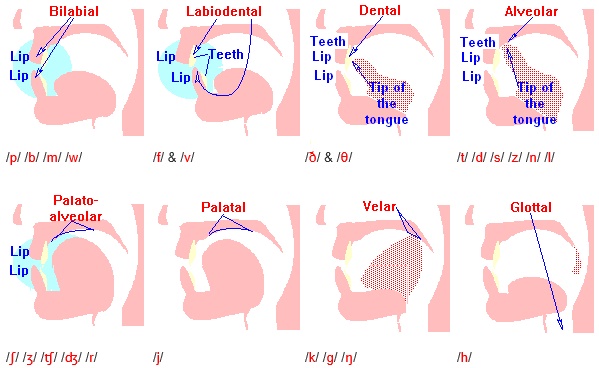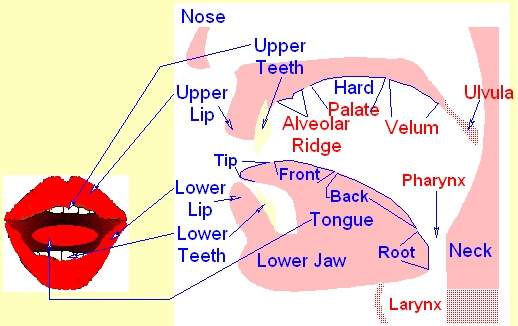Lesson 10
Revision
Spelling to Phonemics
It is easy to confuse the spelling of some sounds with the way those sounds are written; eg.
It is also easy to confuse the shapes of some of the phonemic symbols; eg.
Sometimes one letter has two phonemic symbols together, and sometimes a pair of letters has only one symbol; eg.
Voicing
Voicing is necessary for all vowels, diphthongs, and some consonants.
When you voice a sound, the air from your lungs flows over the vocal cords in your neck before reaching your mouth. This makes the sound louder.
You can check for voicing by putting your hands on your ears and saying /d/. If you voice the sound you will hear /d/ , if you don’t voice it, you will hear /t/. Many of the consonants are in pairs, one unvoiced and one voiced. These pairs are /p/ and /b/, /t/ and /d/, /ʃ/ and /ʒ/,and /ʤ/and /ʧ/, /k/ and /g/, /f/ and /v/, ðə/ (eg. in unstressed ‘the’) and /θɪn/ (e.g. in ‘thin’), and /s/ and /z/. Click these symbols to hear the sounds.
If a sound is unvoiced, the air from your lungs does not make your vocal cords vibrate, and the sound is much quieter.
Some sounds change their voicing because of the different voicing of the sound next to them.
Place of Articulation
Here are some examples of sounds and their place of articulation:

Manner of Articulation
Plosive – /p/ /b/ /t/ /d/ /k/ /g/ The air is trapped in the mouth, then quickly released, making a sound.
Fricative – /f/ /v/ /ð/ /θ/ /s/ /z/ /ʃ/ /ʒ/ /h/ Fricatives are consonants where air escapes through a small gap and makes a hissing sound.
Affricate – /ʧ/ /ʤ/ Affricates are plosives immediately followed by fricatives using the same articulators (parts of the mouth).
Nasal – /m/ /n/ /ŋ/ In nasals the air escapes through the nose.
Lateral – /l/ In laterals the air escapes around the sides of the tongue.
Approximant – /w/ /r/ /j/ A consonant where the articulators get close but do not touch.
Parts of the Mouth
Here are the parts of the mouth.
